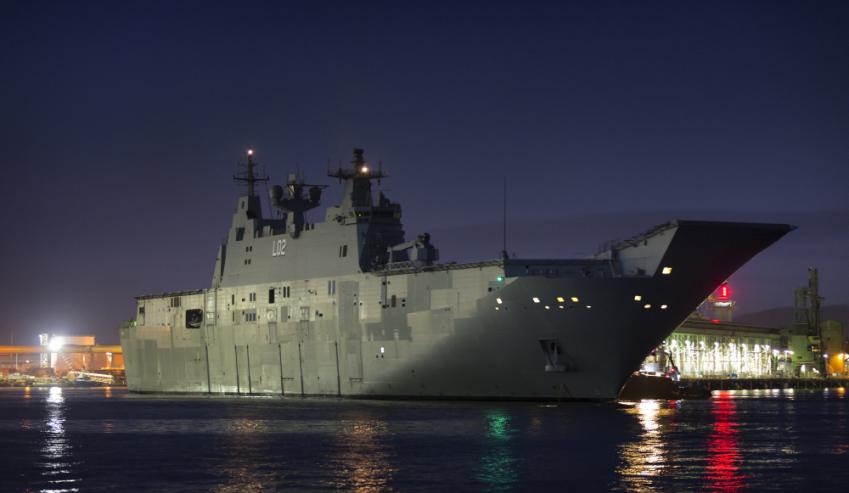The Royal Australian Navy’s Canberra Class landing helicopter docks have achieved final operational capability (FOC), a key milestone for the Navy and its Plan Pelorus strategy for 2022.
To continue reading the rest of this article, please log in.
Create free account to get unlimited news articles and more!
Minister for Defence Linda Reynolds said HMA Ships Adelaide and Canberra are ready to be deployed on amphibious operations such as humanitarian assistance and disaster relief, and amphibious warfare.
These 27,000-tonne ships are able to land a force of over 1,000 personnel by helicopter and water craft, along with all their weapons, ammunition, vehicles and stores.
HMA Ships Adelaide and Canberra are the largest ships ever built for the Royal Australian Navy, the LHDs were built as a collaboration between Navantia and BAE Systems - Maritime.
"The Australian Defence Force’s amphibious capability is an integral part of Australia’s strategic posture and this milestone is another step in Navy’s roadmap to delivering amphibious excellence," Minister Reynolds said.
The ships were constructed using the modular approach whereby the ship is divided into modules, which were built and fitted out as discrete units, before being welded together to form the completed ship. This allowed the ship to be built at a number of different sites across the shipyard before being brought together for final joining.
Construction of the hull to the level of the flight deck, including the majority of fitting out was undertaken at Navantia's Ferrol-Fene shipyard in north-west Spain. The hull was then shipped to BAES' Williamstown shipyard in Victoria for the installation of the island structure. The island modules were constructed at a number of sites around Australian before they were moved to Williamstown for final installation on the flight deck.
The ship's roles are to:
- Embark, transport and deploy an embarked force (Army in the case of the ADF but could equally be an allied Army or Marines), along with their equipment and aviation units; and
- Carry out/support humanitarian missions.
The LHD has been designed with the shallowest possible draft to allow her to operate in secondary ports and harbours as well as manoeuvre tactically in the shallow waters common in the littoral regions. Maximum speed is in excess of 20 knots with a range of 6,000 nautical miles, a sustained maximum speed of 19 knots under full-load conditions and an economic cruising speed of 15 knots with a range of 9,000 nautical miles. She can also reverse with full directional control at up to eight knots.
The LHD has a stern ramp/door that provides access to the well dock for landing craft and vehicles along with a fixed ramp (steel beach) between the well dock and the heavy vehicle/cargo deck (1,410 square metres).
Additionally, two lateral ramp doors are located on the starboard side and provide wharf access to the heavy vehicle/cargo deck for vehicles up to 65 tonnes. Vehicular access between the heavy and light vehicle decks is achieved via a fixed ramp located on the port side.
The well dock is 69.3 metres long and 16.8 metres wide (1,165 square metres) and the LHD will normally carry four LCM 1E. An additional four RHIBs can be carried behind the LCM 1Es, however this will be mission dependent rather than a normal load out.
The well dock has been designed to handle water craft of allied nations, including LCUs, amphibious vehicles and LCACs.
The main accommodation deck is located above the well dock and heavy vehicle/cargo deck and includes crew accommodation, mess decks, medical spaces, galley facilities, office spaces and recreation rooms.
Accommodation is provided for 1,400 personnel; approximately 400 ship’s company including the watercraft and flight deck crews and 1,000 embarked force personnel including the PCRF, embarked flight, HQ staff and landing force.
HMA Ships Adelaide and Canberra will be jointly crewed, with personnel from Navy, Army and the Air Force forming the ship’s company.
Chief of Navy, Vice Admiral Michael Noonan, AO, said Navy is closer to achieving a resilient, sustained and integrated Navy, as outlined in the Plan Pelorus strategy for 2022.
"As we transition to a more technologically advanced Navy, our goal is to be capable of conducting sustained combat operations as part of a joint force," VADM Noonan said.

 Login
Login







